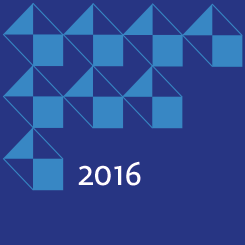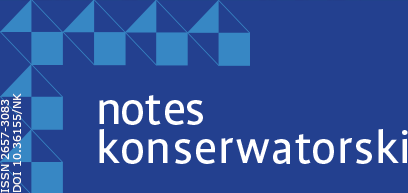
STRONA REDAKCYJNA, s. 2 / CREDITS, p. 2
OD REDAKCJI, s. 9–10 / EDITOR’S NOTE, p. 9-10
POLITYKA OCHRONY I KONSERWACJI ZBIORÓW / PRESERVATION AND CONSERVATION POLICY
Ocena zmian w systemie kontroli obecności owadów w magazynach i zbiorach Biblioteki Uniwersyteckiej we Wrocławiu po wprowadzeniu systemu IPM (Integrated Pest Management) s. 13–31 / Assessment of Changes in the Control of Insects’ Presencein the Depositories and Collections of the Wrocław University Library after the Introduction of the IPM (Integrated Pest Management) System, p. 13–31
This paper focuses on presenting qualitative changes in the system that controls the presence of insects after the introduction of the IPM system inside the Wrocław University Library. The planned transfer of the collections to a new building stimulated the search for a method that would allow precise determination of the collections infestation level and the identification of the pests in question. In 2013 gradual implementation of the new pest control system was launched, and its aim is to cover all the collections in the library. Its introduction enabled precise determination of the species that put the collections in danger, the occurrence of those pests and the possible ways of their extermination. What seems of prime importance is to carry out continuous observation in order to track the changes in the insects’ behaviour and to plan and confirm the efficiency of the preventive actions. The experience acquired so far and that to be gained during the future work should become the basis for the development and implementation of a comprehensive collections protection programme within the Wrocław University Library.
HISTORIA I KONSERWACJA FOTOGRAFII / HISTORY AND CONSERVATION OF PHOTOGRAPHY
Ratowanie materiałów fotograficznych na wypadek wystąpienia katastrofy s. 35–52 / Disaster Preparedness and Recovery of Photographic Materials, p. 35–52
The article focuses on the subject of disaster preparedness and recovery of photographic materials. The author describes an important aspect of it which is the readiness for act in the event of flooding and possible scenarios to follow during a rescue operation, including cleaning, drying and freezing of soaked photographs. The article also discusses the sensitivity of different photographic techniques to water, including objects that should have priority in case of a rescue operation. The text is illustrated with photographs taken during individually performed experiments and workshops.
FIZYKA, CHEMIA I MIKROBIOLOGIA W OCHRONIE I KONSERWACJI ZBIORÓW / PHYSICS, CHEMISTRY AND MICROBIOLOGY IN PRESERVATION AND CONSERVATION
Obrazowanie hiperspektralne w analizie dokumentów i konserwacji sztuki s. 55–75 / Hyperspectral Imaging in the Analysis of Documents and in Art Conservation, p. 55–75
Non-invasive methods, especially spectroscopy, are increasingly used for analyzing materials in art and heritage conservation. Hyperspectral imaging (HSI) is a novel non-contact technique that yields analytical data for the entire object scanned. The article presents the physicochemical foundations of hyperspectral imaging and its main applications in cultural heritage research. Herein HSI has been successfully used for analysing documents and paintings. This technique may be a valuable tool for the assessment and optimisation of conservation procedures as well as for monitoring the influence of storage and exposition conditions on the object. The hyperspectral image of the object (in the form of a datacube) can be analysed both qualitatively and quantitatively that – depending on the object of study, results in i.a. the differentation and identification of colorants, increasing the legibility of the document, detection of hidden elements.
Migracja związków magnezu w bibule Whatman po aplikacji preparatu Bookkeeper, s. 77–101 / Migration of Magnesium Compounds in Whatman Blotting Paper upon the Application of the Bookkeeper Chemical, p. 77–101
The article describes selected results obtained in the frame of the project Research on applying the Bookkeeper chemical to deacidification of oil paintings on paper. This project was carried out in the Faculty of Conservation and Restoration of Works of Art, Academy of Fine Arts in Warsaw, from December 2011 till November 2015, and financed by the National Science Centre. Its purpose was to verify if the deacidification of paper threatened the oil painting layers that cover it. The test samples were prepared using Whatman 3 blotting paper and paint based on linen oil and made by the researchers. The samples were deacidified with the Bookkeeper chemical, whose main ingredient is fine-crystalline MgO suspended in perfluoroheptane (C7F16). The deacidified samples together with the reference samples were subject to two types of ageing tests: part of the samples were aged with light in the CPS + Suntest chamber, while the others were placed in the Klimatest climatic chamber. Specimens extracted from the deacidified and aged test samples were examined with a scanning electron microscope. Images of their rectos and versos were taken, as well as of their cross-sections, and analyses of their elemental composition was performed for different areas of the sample: its surfaces and cross-sections. The mapping of the cross-sections aimed to assess how deep the chemical had penetrated into the blotting paper structure and the painting layer. The experiments confirmed the relationship between the relative humidity of the environment with the efficiency of deacidification as the latter affects the regularity of the distribution of magnesium compounds in the structure of blotting paper.
Wczesna detekcja aktywności pleśni powodujących biodeteriorację obiektów na podłożu papierowym w oparciu o analizę mikrobiologicznych lotnych związków organicznych, s. 103–128 / Early Detection of Active Mould Biodeteriorating Paper-Based Objects by Means of Microbial Volatile Organic Compounds Analysis, p. 103–128
The goal of this work was to analyse the profile of Microbial Volatile Organic Compounds (MVOCs) emitted by mould growing on various paper samples in search for particular volatiles mentioned in the literature as indicators of active mould growth. The mould was cultivated on model samples of acidic paper and on paper made of cotton cellulose. Additionally the measurement was carried out for mould growing on a sample of genuine historical acidic paper and for a sheet of old print with an alteration which indicates the possible presence of mould. The volatiles were sampled with headspace – solid phase microextraction method and analysed with a gas chromatograph – mass spectrometer system. Qualitative and quantitative analyses of the chromatograms were carried out. The results show that the level of MVOCs emission during the studies was high enough to be detected and the highest amount of volatiles was emitted on the sixth day of incubation. However, the intensity of emission was changing in time. It was also found that all of the studied fungi emitted volatiles that had already been suggested to be useful in the detection of the metabolic activity of moulds. Thus, the proposed methodology is promising for the detection of active mould growth on cellulosic objects in situ in libraries, archives, and museums.
Analiza ilościowa mikroorganizmów występujących na powierzchni walizy przechowywanej na terenie byłego KL Auschwitz-Birkenau w Oświęcimiu, s. 129–142 / Quantitative Analysis of the Microorganisms on the Surface of a Suitcase from the Former German Nazi Concentration and Extermination Camp Auschwitz-Birkenau in Oświęcim, p. 129–142
The article presents the results of microbiological examination of a suitcase from the collections of the Auschwitz-Birkenau State Museum in Oświęcim. The difference in the amounts of the microorganisms that were isolated on different parts of the object results from the diversity of materials they are made of, from the sample collection procedure and from the culture medium. Three sample collection procedures and microbiological examination methods are discussed. The results obtained allowed the choice of the most fertile and optimal medium for the culture of the microorganisms in question. They also enabled the adaptation of the specimen collection method to the type of the material.
Z PRAKTYKI KONSERWATORA / FROM A CONSERVATOR’S PRACTICE
Pastel okiem konserwatora, s. 145–172 / Pastel as Seen by a Conservator-Restorer, p. 145–172
In terms of conservation problems complexity pastels are one of the most demanding objects. The article discusses their technological and technical aspects, and describes both the artists’ methods and the materials used by them. The specific character of pastel paintings results in a particular type of damage these works are vulnerable to. The present paper explores the questions related to the practical issues of conservation and restoration, that is all procedures and interventions that seek to protect the work of art.
Drukowane obrazy z końca XIX i XX wieku. Zarys technik drukarskich i fotomechanicznych na podstawie kolekcji oleodruków z Państwowego Muzeum Etnograficznego w Warszawie, s. 173–197 / Painting Prints from the Late 19th Century and the 20th Century. An Overview of Printing and Photomechanical Processes Based on the Collection of Oleographic Prints in the State Ethnographic Museum in Warsaw, p. 173–197
The research on the rich collection of oleographic prints in the State Ethnographic Museum in Warsaw was an opportunity to have a closer look at the phenomena related to the sacred and secular effigies representation in European oleography, to analyse them technologically in detail and to systematize respective Polish terminology.
Problemy atrybucji, chronologizacji i lokalizacji opraw starych druków w kontekście pracy konserwatora książki, s. 199–219 / Attribution, Chronology and Localisation Problems in Early Printed Book Bindings in the Scope of a Book Conservator’s Work, p. 199–219
Where, when and by whom a particular binding was made is not easy to determine given that seldom were early printed books signed by their makers and their imprint may not indicate the place or date of their origin. The determination of the latter requires multifaceted analysis. It is essential to establish who commissioned the binding and to examine its provenience and presence of watermarks or the use of recycled manuscripts, as well as manufacturing and decoration techniques. The co-operation of bookbinding scientists and conservators in order to identify the binding is useful or even necessary for both parties, since any negligence of specific data about the binding that undergoes conservation may cause loss of valuable source material.
KONFERENCJE, WARSZTATY, WYDARZENIA / CONFERENCES, WORKSHOPS, EVENTS
Sympozjum Silver and Gold: Investigating Metalpoint Drawing. Mellon Symposium, Londyn, British Museum, 25 września 2015 roku, s. 223–227 / Silver and Gold: Investigating Metalpoint Drawing Symposium, p. 223–227
Kalendarium wydarzeń 2016, 229–236 / Calendar of Events in 2016, p. 229–236

